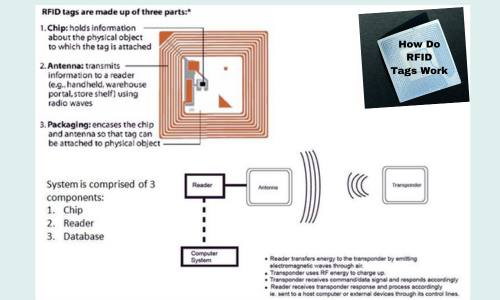
RFID tags have emerged as a game-changer, transforming industries, and enhancing efficiency. Understanding how RFID tags work and their diverse applications can offer insights into their growing importance. Let’s explore the workings of RFID technology and its varied uses across different sectors.
RFID Technology
RFID technology utilizes electromagnetic fields to automatically identify and track tags affixed to objects. Unlike barcodes, which require line-of-sight, RFID tags can be read without direct contact, even from several meters away.
How RFID Works
- The core components of an RFID system are the RFID tag, the reader, and the antenna. Here’s a detailed breakdown of how these components come together:
- RFID Tag: An RFID tag comprises a microchip and an antenna. The microchip stores data about the object, while the antenna transmits this data to the RFID reader. RFID tags are available in two main types: passive and active. Passive RFID tags do not have an internal power source and rely on the reader’s electromagnetic field for power. Active RFID tags, on the other hand, have their power source, usually a battery, and can transmit signals over greater distances.
- RFID Reader: The reader emits radio waves through its antenna to communicate with the RFID tag. When an RFID tag passes through the reader’s electromagnetic zone, it detects the signal from the reader and sends back the stored data.
- Antenna: The antenna, which can be part of both the tag and the reader, plays a crucial role in transmitting and receiving radio waves. The range and functionality of an RFID system largely depend on the type and size of the antenna.
The Science Behind RFID Technology
RFID operates on different frequency bands, including low frequency (LF), high frequency (HF), and ultra-high frequency (UHF). Each frequency band has its advantages and limitations:
- LF (30-300 kHz): Offers short read ranges (up to 10 cm) and is commonly used for access control and animal tagging.
- HF (3-30 MHz): Provides medium read ranges (10 cm to 1 meter) and is used in applications like contactless payment systems and library book tracking.
- UHF (300 MHz to 3 GHz): Allows longer read ranges (up to 12 meters) and is widely used in supply chain management and asset tracking.
RFID technology’s ability to function without direct line-of-sight and its high data transfer rates make it superior to traditional identification methods like barcodes.

Applications of RFID Tags
RFID technology is versatile and finds applications in various industries, enhancing operational efficiency and accuracy. Here are some key areas where RFID tags are making a significant impact:
- Inventory Management
In retail and warehousing, RFID tags streamline inventory management by providing real-time data on stock levels. This helps businesses reduce out-of-stock situations and optimize inventory turnover. By using RFID technology, companies can track products from manufacturing to the point of sale, ensuring better supply chain visibility.
- Healthcare
RFID tags are revolutionizing healthcare by improving patient safety and asset tracking. Hospitals use RFID tags to monitor the location of medical equipment, track patient movements, and ensure that patients receive the correct medications. This technology reduces errors and enhances overall patient care.
- Transportation and Logistics
RFID tags enhance logistics by enabling efficient tracking of goods throughout the supply chain. In transportation, RFID tags are used for tracking vehicles, managing fleet operations, and toll collection. This technology ensures timely delivery of goods and reduces logistical bottlenecks.
- Security and Access Control
RFID technology is widely used in security systems for access control and identity verification. RFID tags embedded in ID cards allow secure entry to buildings and restricted areas. This application is common in corporate offices, educational institutions, and government facilities.
- Animal Tracking
In agriculture, RFID tags are used for tracking livestock and managing animal health records. This helps farmers monitor the well-being of their animals, control breeding programs, and ensure compliance with health regulations.
- Libraries and Asset Management
Libraries use RFID tags to streamline the process of book borrowing and returns. RFID technology helps in quickly locating books, managing inventory, and reducing theft. Similarly, businesses use RFID tags for asset management, ensuring efficient tracking and maintenance of valuable equipment.
- Retail and Consumer Experience
Retailers are leveraging RFID technology to enhance the shopping experience. RFID tags enable smart fitting rooms, where customers can see product information on a screen, and provide seamless checkout processes. This technology also helps in combating counterfeit products by verifying the authenticity of goods.
Conclusion
RFID technology, with its ability to track and identify objects without direct contact, is transforming various industries. From inventory management and healthcare to security and retail, RFID tags offer numerous benefits, including improved efficiency, accuracy, and security. Understanding how RFID works and its diverse applications can help businesses harness this technology to drive growth and innovation.
By incorporating RFID tags into your operations, you can stay ahead of the competition and ensure seamless management of assets and information. As RFID technology continues to advance, its potential applications are endless, offering a future where efficiency and connectivity are crucial.







